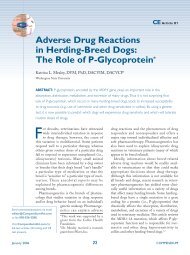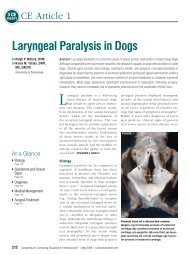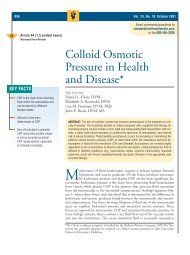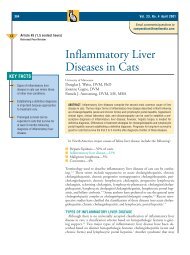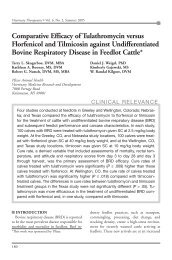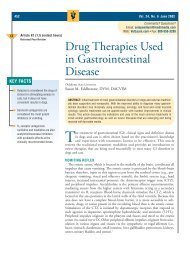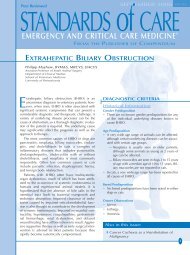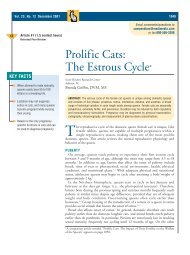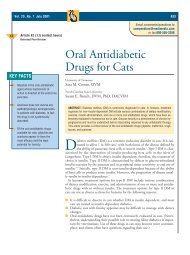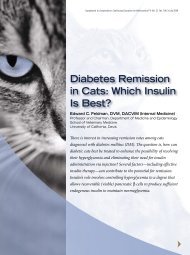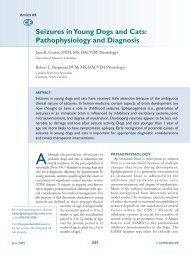Wall-July PV-Review - VetLearn.com
Wall-July PV-Review - VetLearn.com
Wall-July PV-Review - VetLearn.com
- TAGS
- cp.vetlearn.com
Create successful ePaper yourself
Turn your PDF publications into a flip-book with our unique Google optimized e-Paper software.
620 Small Animal/Exotics Compendium August 2002<br />
Figure 5A Figure 5B<br />
Figure 5C Figure 5D<br />
Figure 5—(A) Two-dimensional echocardiogram in the left apical, long-axis, two-chamber imaging plane. During systole, an aortic<br />
valve leaflet thickened by vegetation (arrow) is opened into the aorta (A). There are also vegetations on the mitral valve leaflets<br />
(arrowhead). (B) In diastole, the vegetative aortic valve is closed, and a portion of the vegetation is protruding (arrowhead) into<br />
the left ventricle (LV). The open cranial (anterior) mitral valve leaflet is also thickened by vegetation (arrow). (C) Color-flow<br />
Doppler imaging in systole demonstrating the turbulent mitral regurgitation (arrowhead). (D) Color-flow Doppler imaging in<br />
diastole demonstrating the turbulent jet of aortic regurgitation (arrowhead). LA = left atrium.<br />
ficity, they should always be performed in an attempt<br />
to identify the offending organism. 10,12,14,42,43 Bacteremia<br />
may occur in other conditions, such as diskospondylitis,<br />
chronic wounds, prostate infections, and periodontal<br />
disease. 6,12–14 Performed properly, blood cultures often<br />
yield positive results (in our experience, approximately<br />
30% to 50% of patients have positive results). 6,9–11,13,14<br />
Decreased sensitivity may be explained by fastidious,<br />
slow-growing organisms; improper laboratory techniques;<br />
the failure to culture for anaerobes; low-blood<br />
bacterial concentrations; endogenous bactericidal<br />
factors (<strong>com</strong>plement and phagocytes); intermittent<br />
shedding of the organism; chronic IE with encapsulated<br />
vegetative lesions; or infections with Bartonella.<br />
13,31–33,42–44 Other variables affecting the yield of<br />
microorganisms include the volume of the blood sample,<br />
number of cultures performed, and incubation<br />
atmosphere of the culture. 14,44<br />
www.<strong>VetLearn</strong>.<strong>com</strong><br />
Two or three sets of blood samples should be taken<br />
aseptically, preferably before antibiotic administration.<br />
6,13,14,43,44 Samples should be taken either from a<br />
freshly placed, meticulously maintained jugular<br />
catheter or from different veins. 14,42 Commercial vacuum<br />
bottles should be used. If the animal is receiving<br />
antibiotic therapy, collect the sample at the antibiotic<br />
trough level and use an antibiotic removal device. 14<br />
Duration of antimicrobial therapy is an important factor<br />
in detecting bacteria. 45 Therapy for only 2 to 3 days<br />
may not interfere; however, longer courses of therapy<br />
require the use of antibiotic removal devices or discontinuation<br />
of therapy. Suppression of bacteremia often<br />
persists longer than antibiotic blood levels.<br />
Sterile technique should be practiced when collecting<br />
blood samples. The area must be clipped and disinfected,<br />
and sterile gloves should be worn. Samples (7 to 10<br />
ml of whole blood) should be placed in two bottles:



